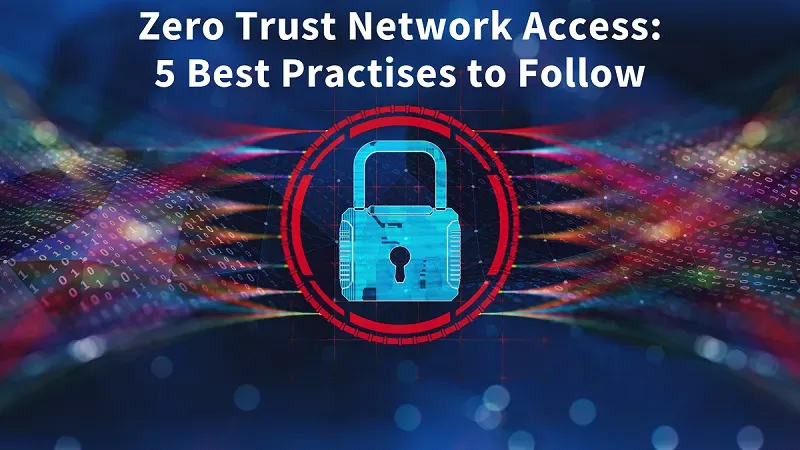Zero Trust Network Access: 5 Best Practises to Follow

Even though the COVID-19 pandemic seems to be gradually subsiding—businesses and enterprises are unwilling to shift back to the offices and instead continue working from remote locations.
While some businesses are returning to the physical office infrastructures, most of them are still working in a hybrid manner to completely remotely. However, cybercriminals take undue advantage of the remote working situation to attack networks and steal critical business information.
Hence, it becomes imperative and increasingly important to implement a secure network access solution, hence Zero Trust Network Access (ZTNA).
ZTNA is a security model that ensures maximum network security and minimises attack surface with a consistent authentication and authorization framework.
In this article, we’ll see the top five best ZTNA practises to follow in your enterprise for maximum network security. But first, let’s learn more about this security model.
What is ZTNA, and What are its Benefits?
Gartner’s research suggests that by 2023—60% of organisations and enterprises are anticipated to adopt ZTNA for multiple use cases.
Zero Trust Network Access is a Zero Trust Security model that ensures secure network access and creates fast and encrypted connections, and connects servers and applications at the network level seamlessly.
You can secure your SAP applications, IP access, Linux machines, and even thick client applications.
Here are some critical benefits of this Zero Trust Network model:
- Creates private connections and encrypted tunnels from user devices to the network locations they wish to access.
- Removes exposed IP addresses to make your enterprise network inaccessible to the internet.
- Secures your data with end-to-end encryption.
- Ensures complete risk and trust assessment for every access request.
- Works on the “Never Trust, Always Verify” principle and by default employs a deny-all approach to remove excessive network trust.
5 Best ZTNA Practises to Follow
Here are some of the best ZTNA Zero Trust Network architecture practises to follow for your enterprise.
Trust no one
It’s important to implement and deploy a security approach that trusts no one, any user outside or inside the enterprise, and already assumes the network to be compromised. It eliminates the assumption of trust—no matter if the user is from the Local Area Network (LAN) or the external networks.
It provides authenticated access to applications and networks the user is verified and authenticated.
Thus, ZTNA’s “trust no one” is one of the best practises that continually evaluate risks and prevent unauthorised and compromised access to the network.
Implement micro-segmentation
Perimeter-based access control is no longer efficient and proves irrelevant in today’s increasingly cybersecurity and online risks.
Thus, ZTNA’s Zero Trust Network design implements micro-segmentation that deploys user verification and authentication to each network location and end-point.
Thus, instead of a single large perimeter, it creates separate security perimeters in smaller zones with separate access rules to ensure data security by reducing the system attack surface size.
Grant least privilege access
You aren’t required to grant entire network access to all your employees to minimise the surface attack and internal security risks.
With ZTNA in place, it ensures user access only to specific applications and business resources required to perform authorised tasks to each user or individual.
According to the granular policies, you should grant access on the “need-to-know” or least privilege level of access. By narrowing the back-end services and access—you can minimise exposure and data breach risks.
Ensure IT regulatory compliance
The ZTNA Zero Trust Security concept allows you to implement robust and strict user access policies and controls to ensure the internal network protection of your organisation.
In addition, it also helps meet IT regulatory compliance requirements and law requirements.
Implement ZTNA and VPNs side-by-side
Third-party entities like contractors, vendors, and partners are easy targets for hackers and cannot be trusted as they might not know or take organisational security policies seriously or pay close attention to them.
These entities don’t necessarily require complete access to your network, and hence you can use ZTNA and VPNs side by side.
While your employees or internal users can use VPNs—you can use ZTNA to grant authorised access to third-party users to specific applications or locations. It helps save costs, ensure security, and create a safe working environment.
Conclusion
ZTNA is a perfect Zero Trust Security model to secure your network applications and prevent unauthorised and untrusted access to your networks. Thus, follow the ZTNA best practises mentioned above for your enterprise network to prevent data breaches and keep cybercriminals and hackers at bay.
You can check out our InstaSafe solutions—including Zero Trust Network Access to leverage granular access controls, high network visibility, and passwordless authentication. You can contact and get in touch with us or even book a demo to get started.
Key Products
Zero Trust Application Access | Zero Trust Network Access | Multi Factor Authentication | IAM Identity And Access Management | Secure Enterprise Browser
Key Features
SSO Single Sign On | Endpoint Security | Contextual Based Access Controls | Always On VPN Connection |Clientless VPN | Device Binding | Device Posture Check | Domain Joining
Key Solutions
VPN Alternative Technology | Secure Remote Access Solutions | Cloud Application Security | DevOps Security | VoIP Security Solutions
